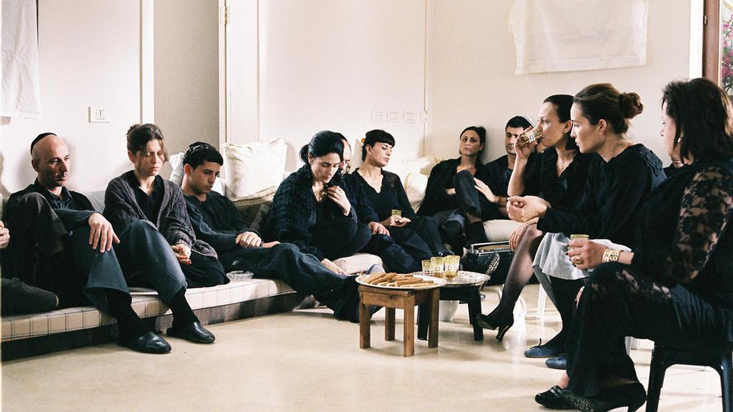My first exposure to the death of a patient came during my third year of medical school, in Israel. It was my first clinical rotation, which happened to be in internal medicine. Tagging along with my mentor, a senior physician to whom I had been assigned, on his morning rounds, we entered the room of an elderly woman who was critically ill with an antibiotic-resistant bacteria in her urinary system. The infection had spread throughout her frail body and was now wreaking havoc on most of her vital organs. Observing her for a few moments as she lay there unconscious, he said, “She’s almost at the end.”
I scrutinized the woman’s face, her breathing, the digital readouts of the instruments, trying to understand what signs he was so brilliantly interpreting. To me it seemed like voodoo, as though through some dark art he was able to peer into her very soul.

Assuming that with nothing more to do here we would move on, I began to back away toward the door. But he surprised me by pulling a chair up to the bedside, sitting down, and taking one of the woman’s limp hands in his own. I realize now that in addition to providing her with the comfort of a human touch, he was also probably assessing her pulse, feeling her skin growing cooler, judging the blood flow to her extremities. But at the time I saw it simply as a kind human gesture, all the more startling because, though so simple, it struck me as a profound part of what it means to be a healer. Even though I was only a medical student, I was already so lost in my books, so focused on physiology and on memorizing for tests, that I had forgotten for a moment what I was really training for.
“She has no family here,” he said. “Never forget, if you accompany your patients only until the battle is lost and they are dying, if you abandon them at that point and leave them alone, you have done only part of your job, and not done it well. Your job is to accompany your patients until they are either better or safely on the other side.”
I sat in a chair on the opposite side of the bed, not yet brave enough to hold her other hand but trying to take it all in.
What he was saying sounded vaguely familiar, but from a very different context. I was reminded of the funeral of my first grandparent to die, my maternal grandfather, when I was 15 years old. At the graveside, after the few people in attendance had each thrown the traditional shovel-full of earth into the open grave and I had moved off to the side, my father called me back.
“Take this,” he said, keeping one shovel for himself and holding the other out for me, “we have to keep going until the grave is fully covered.”
“Why?” I asked. “I already put some dirt in.” I was still in the process of absorbing the loss of my grandfather and was in no hurry to participate in something so morbid.
“There’s no one else here who can do it,” he said. “The greatest thing you can do for him now as a grandson is to help me see to it that he is fully buried by us, his own family, and not just left for strangers to fill in the grave with a tractor.”
It was incredibly difficult for me but I did it, of course, down to the last shovel-full. And the experience stayed with me.
In the hospital room with my mentor and the dying woman, I sat down in a chair on the opposite side of the bed, not yet brave enough to hold her other hand but trying to take it all in. Except for the sounds of the three of us breathing the room was still. As the minutes passed, the woman’s breathing became slower, wetter, more ragged. And then, suddenly, it just stopped. She was gone. I had witnessed my first death.
After he checked that there was no pulse and that she was indeed deceased, my mentor notified the nurse in charge, quickly signed the death certificate, and we moved on to the next patient on our rounds.
In one respect, which I didn’t fully appreciate at the time, this was amazing. My mentor had demonstrated an incredibly valuable and, I would come to realize, incredibly difficult skill: how to be present during a death. But the same time, I would later come to understand that he also displayed a poor adaptive response commonly seen in clinicians. He signed the certificate and moved on. That was it. To be fair, I don’t know what was going on in his head, if he was hurting inside and saving it up until after work, or if he was truly so jaded and busy that he was unaffected by the death of his patient. All I saw as a student was that the patient was dead and we were expected to move on, with no comment or reflection on what had just occurred.
My understanding then and throughout my training was that with the departure of the doctor after the death of a patient, the nursing staff takes over. They would provide support to the patient’s family and prepare the body to be moved to the hospital morgue. But as a medical student and later as a resident I had no idea what any of this entailed. It’s not part of a doctor’s training. During my pediatric oncology training the workload was so great and patient deaths so frequent, there never seemed to be time for me to even think about what happens to the body. And, in any case, I soon realized that expressing concerns about these sorts of things was neither encouraged nor supported; in fact, I worried it would be perceived as a show of weakness.
At Hadassah, as a senior physician, I finally have more of an opportunity to observe what happens after the death of a patient. Because, in accordance with their religious traditions, most Jews and Muslims want to bury their deceased before sunset on the day of death (and because both religious traditions specify the avoidance of autopsies at all costs), things tend to move pretty quickly. Family members are allowed as much time as they need in the room with the child, but in the meantime, we fill out and register a death certificate with the hospital clerks, a process that always seems fast and efficient. Israel’s bureaucracy is legendary, and Hadassah is generally no exception, but somehow the issuing of the death certificate always moves along quickly. It’s almost as if there is a recognition that something terribly sad has occurred, and that the usual bureaucratic shenanigans of daily life at Hadassah should be set aside to allow a bereaved family to proceed swiftly and peacefully to their loved one’s funeral.
Once the family has had some time alone in the room, we suggest that they step out so that we can clean the body. This is different from the ritual washing that the body will undergo once it has been transported to the appropriate burial society. But our washing and cleaning does take on its own special aura of ritual, and it’s almost as if families recognize that there is something sacred about this final act that we carry out for our patients. Even the Haredi families, usually so protective of their own, allow us this special role. Death can be messy, even when peaceful. It may involve bleeding or the loss of fluids from any number of tubes and openings. As we clean the body with sponges and soapy water, we wipe away stains and clean any lacerations. We remove tubes, IVs, catheters, and tape, and even occasionally sew up wounds left after the removal of tubes and instruments, so that there is no ongoing spillage as the body is moved and so that the signs of disease and treatment are minimized. I’ve always felt that this allows us to return some dignity to the patient, to erase some of the ravages of the dying process.

The first time a nurse asked me if I would help I hesitated. My job is done, my patient has passed away, why would I want to take part in something so, well, unpleasant? It was only later that I realized the invitation was not an attempt at offloading work onto me but, rather, a respectful invitation. An honor, even. Being allowed to help clean my patient’s body after his death, after my own treatments had failed, was an opportunity for me to provide one last act of kindness toward him. The patient, Dov, was a young man who had died of a progressive bone tumor. In the course of his treatment, one leg had been amputated. Despite that, the tumor had returned, spreading through his body and leaving the stump of his leg a swollen, rotting mass. The nurse caring for him very compassionately asked his family to wait outside as I went back into the room with her. Knowing what cancer can do to a person, my heart raced as I braced myself for what his exposed body might look like. She peeled back the sheets and, indeed, the stump and most of his lower body were engulfed and warped by the tumor. In several places the tumor had caused swelling and had even erupted from his body in fungus-like masses. I breathed through my mouth, afraid to smell the rotting flesh, and I focused on the nurse. She didn’t flinch once. I followed her lead as she deftly, even lovingly, removed the tubes and wires still stuck to Dov. She wiped the sweat and blood from his motionless body, rolling him from right to left and then back again, to make sure nothing was missed. Together we lifted him onto a clean sheet, slipping the soiled ones out from underneath, and wrapped him so that only his head and face showed. The whole process seemed to transform him in just a few minutes from a victim of disease and its treatments to the picture of a young man finally at rest.
What surprised me most was that the process was also transformative for me. I felt a sense of fulfillment of my responsibility to this person who had been entrusted into my care. I was not in any way more reconciled with or any less sad about the death of my patient. But I had long sensed that just walking away from my patient once he had been declared dead left some part of the work unfinished. In this preparation of Dov’s body, our staff carried out our final responsibilities to him, helping him complete his journey with dignity.
In pediatric oncology most patient deaths do not come as a complete surprise. Usually we know when the odds are worsening and our patient is heading down a path with only one realistic ending. But actually predicting how much time remains for a patient is notoriously difficult, in contrast to what you might think based on the movies when the doctor so confidently and grimly predicts that, “you’ve got six months to live.” How long a terminally ill patient has left to live may depend on a number of factors, many of which are not under our control. This makes the timing of critical discussions about decision-making and interventions incredibly important. At Hadassah, the point at which we see a child’s disease progressing despite therapy is when we typically begin discussions with the parents about what to do should something happen suddenly. We need to know what sort of resuscitation efforts should be made if a patient stops breathing (in which case the team might consider intubation and mechanical ventilation) or if her heart stops beating (in which case the team might attempt cardio-pulmonary resuscitation, or CPR). We refer to these sorts of discussions, the exploration of what the end might look like and what interventions make the most sense to a family, as advance care planning.
Not having these conversations early enough may lead to unnecessary suffering by both the patient and her family.
One issue that gets in the way of preparing for these possibilities is our Western culture’s near-obsessive insistence on death as a discrete, identifiable moment. This may be a convenient way of viewing death for a number of reasons—for legal and administrative purposes, such as registering time of death and tracking data, or psychologically, as a way of quantifying death as a thing that we can then plan to stave off and “defeat.” But death is not always so simple, so quantifiable. I now suspect that the first death I had witnessed in medical school, which I experienced as “here one minute, gone the next,” was far more complex than I was able to appreciate at the time. The reason my mentor had us stay with his dying patient that day was probably that he saw that the dying process had already begun. All of my clinical experience since those early days as a student has only strengthened my sense that death is a process, and not just a moment in time.
Most religious and spiritual traditions seem to recognize this as well, and often do a better job of accommodating this reality than our own medical system does. Within the Jewish tradition, for example, there is a specific term, goseis, used to indicate a person who is what the medical profession calls “actively dying,” who doctors believe has no more than hours or days left to live. According to kabalistic traditions, the soul of the departed person remains present in the home during the week that the family sits shiva (which is one of the reasons the mirrors in the home are traditionally covered, so that the soul won’t experience painful reminders that it no longer has a corporeal presence). There are non-Western traditions that incorporate this concept even more overtly into their beliefs surrounding death and dying. In the Tibetan Buddhist tradition, when death appears to be approaching, holy men are brought to the bedside to chant prayers. Once the point is reached that we in the West would call “time of death,” the holy men continue praying for three more days, which is considered to be a time of active transition for the spirit from one state to the next.
The inability, or unwillingness, to recognize death as a process inevitably leads to problems with having advance care planning discussions. Advance care planning doesn’t mean “giving up” on a patient and stopping all forms of treatment. It simply means talking through with the patient and family members the “what-ifs” before a crisis ensues, and discussing in a relatively calm setting what procedures are most in line with the family’s goals and religious or philosophical values. It doesn’t mean that a patient has to stop hoping for a remission or even for a cure, or stop pursuing active treatments. It just means preparing for other, more likely, possibilities. But however logical and reasonable this may seem in the abstract, pursing this type of conversation is for many reasons often difficult for everyone—clinicians, patients, and families alike.
Clinicians are human beings too, and they can sometimes engage in their own form of denial regarding signs of progressive disease or impending death in their patients. Or they may feel that this type of conversation is an acknowledgement of their own failure. They may worry that an unintended outcome of the conversation will be the loss of hope on the part of the patient and family. Whatever the reason, this is a difficult conversation for clinicians to initiate. They often avoid it by saying that the family “isn’t there yet,” in other words, isn’t ready to face the possibility that their child will not be cured of her disease. But not having these conversations early enough may lead to unnecessary suffering by both the patient and her family, with death occurring amidst a panicked, hurried mess of regrets over things left unsaid, and comfort-oriented options not pursued. And all too often the family is, indeed, “there”; they’re just waiting for the clinical team to open the discussion. The timing of advance care planning discussions can be tricky and, much like identifying a time of death, it can be difficult to identify a moment or trigger for starting the discussion.
There are better and worse ways to navigate these discussions. The clunkiest and possibly worst consists of a clinician laying out to parents the options of “doing everything” versus “just making the child comfortable.” Unfortunately, this is sometimes how things are presented. It suggests, erroneously, that parents are faced with an “either/or” proposition: We will make your child feel comfortable, or we will use extraordinary measures to try to keep her alive. Worse yet, we lay this unnecessary decision squarely on the ill-prepared shoulders of bewildered, grief-stricken parents. Alternatively, these conversations could happen in the context of a long-term relationship that has been established between the clinician and the family, during which a family’s goals, values, and expectations have been thought through. In these instances, clinicians are able to provide guidance to parents on decision-making and to suggest that, based on a family’s beliefs or goals, there might be certain procedures or interventions that should or should not be done. This is often where a palliative care team can be helpful, especially if they have been introduced early enough and have developed a relationship with the child and her family.
Advanced care planning is another realm where the rabbinic authorities in Israel play a major role, especially when it comes to the Haredi population. In the ideal world, communication between a patient’s rabbi and the medical team would be seamless, everyone working together to explore goals, hopes, and fears in order to come up with a plan that is both medically and religiously or culturally appropriate for a given family. But in reality that sort of relationship rarely materializes. Our medical determinations and suggestions are more often sketchily conveyed by heartbroken parents to rabbis who can therefore have at best only a limited understanding of the patient’s medical situation and prognosis. And so when we have advance care conversations with these families, what we most often hear is “the rabbi says that as long as there is life we must do everything possible.” Though it sounds definitive, there is an ambiguity in this response. Some clinicians will take this statement at face value and interpret it to mean that every attempt at resuscitation should be made no matter what. This will sometimes result in clinicians performing painful and pointless procedures on a dying child as weeping parents stand by, watching their child’s final moments in horror, having not understood what they were signing on for. But sometimes clinicians will dig deeper, sensing that there are unresolved issues inherent in the statement. What is “everything” they may ask? And when does “life” actually end? When is an action considered a reasonable intervention and when is it considered excessive and futile? When might an intervention actually fall into a category that is beyond “everything?” Often in my experience at Hadassah, when parents witness their child dying, when they see that the final moments are truly at hand, if we have developed a trusting relationship with them and have been engaging in these discussions over time, they tell us that attempting resuscitative efforts that are likely to be futile is not consistent with their values. In these situations, rather than asking for intubation and chest compressions, parents just want to hold their child and find meaning in those final moments of contact.

Elisha Waldman is associate chief, division of pediatric palliative care, at the Ann and Robert H. Lurie Children’s Hospital of Chicago. He received his bachelor’s degree from Yale University and his medical degree from the Sackler School of Medicine in Tel Aviv. His writing has appeared in Bellevue Literary Review and the Hill.
From the book: This Narrow Space by Elisha Waldman. Copyright © 2018 by Elisha Waldman. Published by arrangement with Schocken Books, an imprint of the Knopf Doubleday Publishing Group, a division of Penguin Random House LLC.


























